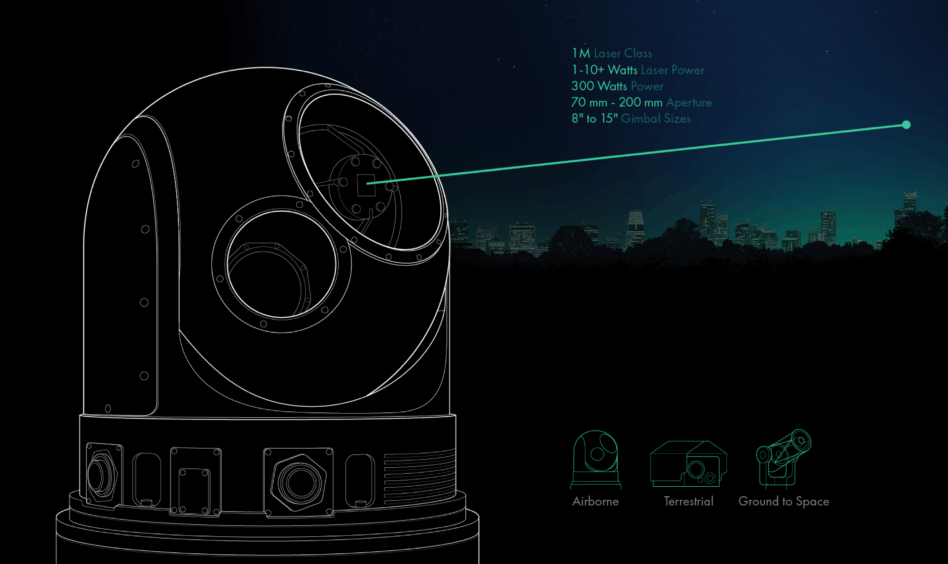Pew pew is back, baby. This morning, laser communications company Aalyria—a spinoff of Google—announced that their Tightbeam system has achieved two major technical milestones as part of a $7M contract to develop over-the-horizon connectivity with the Navy Research Laboratory:
- A 65-kilometer optical link (a concentrated laser beam that can transmit data) they deployed in mountain-to-mountain terrain sustained speeds of 100 Gbps continuously (like, 24/7), even in real-world atmospheric conditions. That’s fast, and the company says it’s a feat that’s never been achieved before.
- Plus, Tightbeam also maintained connectivity in a maritime demonstration at the NRL, even at a simulated Sea State 3.5—the highest level available on the simulator.
These both represent a major breakthrough in overcoming atmospheric complications in laser communication close to the Earth’s surface, Aalyria CEO Chris Taylor told Tectonic.
“When you send a laser beam through the atmosphere, you’re fighting nature every step of the way. Heat, turbulence, moisture, dust—these all distort and scatter the signal, and those effects multiply the farther you go,” he said via email, “What we’ve demonstrated with Tightbeam is the ability to push through those challenges.”
Pew pew: First, a bit of a primer on laser communications (also called optical communications) for the uninitiated among us.
Here on earth, most data is transmitted using radio (RF) waves. Laser communication systems use highly concentrated beams of light to transmit data instead.
This provides a few benefits:
- Higher bandwidth: Laser links can carry 10–100x more data than traditional RF links in the same amount of spectrum.
- Spectrum relief: RF spectrum is crowded, while optical bands are much less congested.
- Lower probability of interception: Narrow beams are harder to detect and jam.
Terminals can also be smaller and more power-efficient than their RF counterparts.
Way out there: Today, a lot of laser comms use is space-related.
- Space-to-space links: Satellites transmit data via laser beams without going through ground stations.
- Space-to-ground links: Laser comms allow satellites to transmit high-volume data (like images of Earth) to the ground faster than RF allows.
Lasers are also sometimes used to transmit data securely between military installations—bases, vessels, and outposts—as well as from high-altitude platforms, like drones, down to the ground.
But here’s the issue: Because laser communication transmits data using light, it can be thrown off by atmospheric and weather conditions.
- Variations in air temperature and density cause the light beam to scintillate (or twinkle) and wander, which degrades signal quality.
- Optical beams also traditionally don’t penetrate well through clouds, fog, dust, and the like—dense cloud cover can cut off a laser comms beam entirely.
That means that, to date, laser comms close to the earth’s surface have been pretty limited because, well, we have weather. Aalyria was founded to figure out a way around this.
Tighten up: Aalyria started as a secret project within Google codenamed “Minkowski,” then spun out into its own company in 2022. In a release at the time, they said their aim was to build “hyper fast, ultra-secure, and highly complex communications networks that span land, sea, air, near space, and deep space.”
Aalyria has developed two systems:
- Tightbeam: The laser comms system, which the company says can deliver “fiber-equivalent speeds wirelessly through atmospheric conditions where traditional infrastructure cannot reach.”
- Spacetime: A software-defined networking platform (PaaS) that can coordinate “large and constantly-changing communications networks with steerable or directional signals—like satellite constellations and airborne mesh networks.” Think of this as the brain that coordinates the comms.
Google invested its own funding to develop the tech for years, Taylor said, which saved Aalyria some of the financial burden (they acquired the IP when they spun out). The breakthrough in Tightbeam’s ability to operate in the Earth’s atmosphere comes from “ultra-precise beam control and real-time atmospheric correction to maintain stable, high-throughput connections.”
The company was awarded a DIU contract with a $31.7M ceiling in 2022, according to Obviant data, to develop a hybrid space architecture prototype (alongside Anduril, Enveil, and Atlas Space).
- They won the $7M NRL contract in 2023 as part of the Navy’s Secure Optical Aerial Relay (SOAR) project.
- They were contracted by NASA in 2024 to “conduct a comprehensive Network Orchestration and Management System (NOMS) study and demonstration.”
- In October 2024, the company was one of 20 selected as part of a Space Force Rapid Capabilities Office (RCO) IDIQ with a cap of $1B to modernize satellite tactical ground operations.
Link it up: Now that the company has demonstrated the efficacy of its tech at such long distances and through real-world atmospheric conditions, Taylor said, it opens the door to massive networking potential on the battlefield or at sea.
“Picture a battlespace where ships, ground stations, satellites, and airborne platforms all carry Tightbeam technology,” he said, “Each can beam connectivity to the others, and Spacetime intelligently routes the communications paths in real time.”
Tightbeam-equipped assets would form a “self-healing optical mesh network that spans land, air, sea, and eventually space,” he added. “If one node goes down—whether due to weather, maneuvering, or adversary action—the network instantly reconfigures, preserving connectivity.”
Get to work: While Taylor couldn’t tell us how quickly Tightbeam would be installed on Navy vessels, he said they are “moving towards operational integration.”
“Tightbeam is no longer theoretical—it’s headed for the field, and the number of platforms capable of this kind of connectivity will only grow from here,” he said.
Show me the money: And as for funding? Taylor didn’t rule out looking for new financial backers soon. “If we decide that we need financial partners, it will be with those…who clearly see the vision that we see,” he said. “We are confident you will be hearing about our exponential growth very, very soon.”

